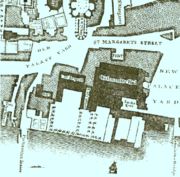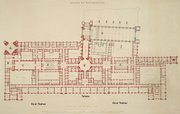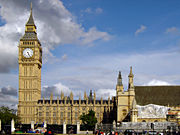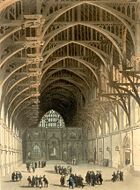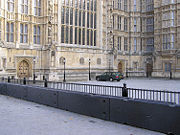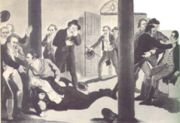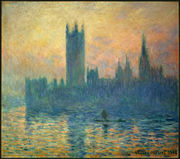Palace of Westminster
2008/9 Schools Wikipedia Selection. Related subjects: Architecture
| Westminster Palace, Westminster Abbey and Saint Margaret's Church* | |
|---|---|
| UNESCO World Heritage Site | |
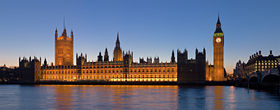 |
|
| Type | Cultural |
| Criteria | i, ii, iv |
| Reference | 426 |
| Region† | Europe and North America |
| Inscription history | |
| Inscription | 1987 (11th Session) |
| * Name as inscribed on World Heritage List. † Region as classified by UNESCO. |
|
The Palace of Westminster, also known as the Houses of Parliament or Westminster Palace, in London, is where the two Houses of the Parliament of the United Kingdom (the House of Lords and the House of Commons) meet. The palace lies on the north bank of the River Thames in the London borough of the City of Westminster, close to other government buildings in Whitehall.
The palace's layout is intricate: its existing buildings contain around 1,100 rooms, 100 staircases and 4.8 kilometres (3 mi) of corridors. Although the building mainly dates from the 19th century, remaining elements of the original historic buildings include Westminster Hall, used today for major public ceremonial events such as lyings in state, and the Jewel Tower.
Control of the Palace of Westminster and its precincts was for centuries exercised by the Queen's representative, the Lord Great Chamberlain. By agreement with the Crown, control passed to the two Houses in 1965. Certain ceremonial rooms continue to be controlled by the Lord Great Chamberlain.
After a fire in 1834, the present Houses of Parliament were built over the next 30 years. They were the work of the architect Sir Charles Barry (1795–1860) and his assistant Augustus Welby Pugin (1812–52). The design incorporated Westminster Hall and the remains of St Stephen's Chapel.
History
The Palace of Westminster site was strategically important during the Middle Ages, as it was located on the banks of the River Thames. Buildings have occupied the site since at least Saxon times. Known in medieval times as Thorney Island, the site may have been first-used for a royal residence by Canute the Great (reigned 1016–1035). St Edward the Confessor, the penultimate Saxon monarch of England, built a royal palace on Thorney Island just west of the City of London at about the same time as he built Westminster Abbey (1045–1050). Thorney Island and the surrounding area soon became known as Westminster (a contraction of the words West Monastery). After the Norman Conquest in 1066, King William I established himself at the Tower of London, but later moved to Westminster. Neither the buildings used by the Saxons nor those used by William I survive. The oldest existing part of the Palace (Westminster Hall) dates from the reign of William I's successor, King William II.
The Palace of Westminster was the monarch's principal residence in the late Medieval period. The predecessor of Parliament, the Curia Regis (Royal Council), met in Westminster Hall (although it followed the King when he moved to other palaces). The Model Parliament, the first official Parliament of England, met in the Palace in 1295; almost all subsequent Parliaments have met there.
The Jewel Tower was built in approximately 1365 to house the treasures of Edward III.
Westminster remained the monarch's chief London residence until a fire destroyed part of the structure in 1512. In 1530 King Henry VIII acquired York Palace from Thomas Cardinal Wolsey, a powerful minister who had lost the King's favour. Renaming it the Palace of Whitehall, Henry VIII used it as his principal residence. Although Westminster officially remained a royal palace, it was used by the two Houses of Parliament and as a law court.
Because it was originally a royal residence, the Palace included no purpose-built chambers for the two Houses. Important state ceremonies, including the State Opening of Parliament, were held in the Painted Chamber; the House of Lords usually met in the White Chamber. The House of Commons, however, did not have a chamber of its own, and sometimes held its debates in the Chapter House of Westminster Abbey. The Commons acquired a permanent home in the Palace— St Stephen's Chapel, a former royal chapel—only during the reign of Henry VIII's successor, King Edward VI. The Chantries Act 1547 (passed as a part of the Protestant Reformation) dissolved the religious order of the Canons of St Stephen's, among other institutions; thus, the Chapel became available for the Commons' use. Alterations were made to St Stephen's Chapel for the convenience of the lower House.
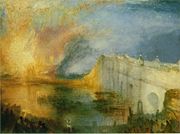
On 16 October 1834, most of the Palace was destroyed by fire. Only Westminster Hall, the Jewel Tower, the crypt of St Stephen's Chapel and the cloisters survived. A Royal Commission was appointed to study the rebuilding of the Palace and a heated public debate over the proposed styles ensued. The neo-Classical design, similar to that of the White House and Congress in the United States, was popular at the time, but had connotations of revolution and republicanism, whereas Gothic design embodied conservative values. The Commission announced in June 1835 that "the style of the buildings would be either Gothic or Elizabethan".
In 1836, after studying 97 rival proposals, the Royal Commission chose Charles Barry's plan for a Gothic-style palace. The foundation stone was laid in 1840; the Lords Chamber was completed in 1847, and the Commons Chamber in 1852 (at which point Barry received a knighthood). Although most of the work had been carried out by 1860, construction was not finished until a decade afterwards. Barry (whose own architectural style was more classical than Gothic) relied heavily on Augustus Pugin for the sumptuous and distinctive Gothic interiors, including wallpapers, carvings, stained glass and furnishings, like the royal thrones and canopies.
During the Second World War, the Palace of Westminster was hit fourteen times by bombs. The worst of these was on 10 May 1941, when the Commons Chamber was destroyed and three people were killed. The chamber was re-built under the architect Giles Gilbert Scott; the work was completed in 1950.
As the need for office space in the Palace increased, Parliament acquired office space in the nearby Norman Shaw Building in 1975, and more recently in the custom-built Portcullis House, completed in 2000. This increase has now allowed all MPs to have their own office facilities.
Exterior
Sir Charles Barry's collaborative design for the Palace of Westminster uses the Perpendicular Gothic style, which was popular during the 15th century and returned during the Gothic revival of the 19th century. Barry was a classical architect, but he was aided by the Gothic architect Augustus Pugin. Westminster Hall, which was built in the 11th century and survived the fire of 1834, was incorporated in Barry's design. Pugin was displeased with the result of the work, especially with the symmetrical layout designed by Barry; he famously remarked, "All Grecian, sir; Tudor details on a classic body".
Stonework
The stonework of the building was originally Anston, a sand-coloured magnesian limestone quarried in the village of Anston in South Yorkshire. The stone, however, soon began to decay due to pollution and the poor quality of some of the stone used. Although such defects were clear as early as 1849, nothing was done for the remainder of the 19th century. During the 1910s, however, it became clear that some of the stonework had to be replaced.
In 1928 it was deemed necessary to use Clipsham Stone, a honey-coloured limestone from Rutland, to replace the decayed Anston. The project began in the 1930s but was halted due to the Second World War, and completed only during the 1950s. By the 1960s pollution had once again begun to take its toll. A stone conservation and restoration programme to the external elevations and towers began in 1981, and ended in 1994. The House Authorities have since been undertaking the external restoration of the many inner courtyards and this is due to continue until approximately 2010.
Towers
Sir Charles Barry's Palace of Westminster includes several towers. The tallest is the 98.5-metre (323 ft) Victoria Tower, a square tower at the south-western end of the Palace. It was named after the reigning monarch at the time of the reconstruction of the Palace, Queen Victoria; today, it is home to the Parliamentary Archives. Atop the Victoria Tower is an iron flagstaff, from which either the Royal Standard (if the Sovereign is present in the Palace) or the Union Flag is flown. At the base of the tower is the Sovereign's Entrance to the Palace, used by the monarch whenever entering the Palace of Westminster for the State Opening of Parliament or for any other official ceremony.
Over the middle of the Palace lies St Stephen's Tower, also called the Central Tower. It is 91.4 metres (300 ft) tall, making it the shortest of the three principal towers of the Palace. Unlike the other towers, St Stephen's Tower possesses a spire. It stands immediately above the Central Lobby, and is octagonal. Its function was originally a high-level air intake.
A small tower is positioned at the front of the Palace, between Westminster Hall and Old Palace Yard, and contains the main entrance to the House of Commons at its base, known as St Stephen's entrance.
At the north-eastern end of the Palace is the most famous of the towers, the Clock Tower, which is 96.3 metres (316 ft) tall. Pugin's drawings for the tower were the last work he did for Barry. The Clock Tower houses a large, four-faced clock—the Great Clock of Westminster—also designed by Pugin. The tower also houses five bells, which strike the Westminster Chimes every quarter hour. The largest and most famous of the bells is Big Ben (officially The Great Bell of Westminster), which strikes the hour. This is the third heaviest bell in England, weighing 13.8 tonnes (13.6 long tons). Although Big Ben properly refers only to the bell, it is often colloquially applied to the whole tower.
Grounds
There are a number of small gardens surrounding the Palace of Westminster. Victoria Tower Gardens is open as a public park along the side of the river south of the palace. Black Rod's Garden (named after the office of Gentleman Usher of the Black Rod) is closed to the public and is used as a private entrance. Old Palace Yard, in front of the Palace, is paved over and covered in concrete security blocks (see security below). Cromwell Green (also on the frontage, and in 2006 enclosed by hoardings for the construction of a new visitor centre), New Palace Yard (on the north side) and Speaker's Green (directly north of the Palace) are all private and closed to the public. College Green, opposite the House of Lords, is a small triangular green commonly used for television interviews with politicians.
Interior
The Palace of Westminster includes over 1,100 rooms, 100 staircases and 4.8 kilometres (3 mi) of passageways. The building includes four floors; the ground floor includes offices, dining rooms and bars. The "first floor" (known as the principal floor) houses the main rooms of the Palace, including the Chambers, the lobbies and the libraries. The Robing Room, the Royal Gallery, the Prince's Chamber, the Lords Chamber, the Peers' Lobby, the Central Lobby, the Members' Lobby and the Commons Chamber all lie in a straight line on this floor, from south to north, in the order noted. (Westminster Hall lies to a side at the Commons end of the Palace.) The top-two floors are used for committee rooms and offices.
Formerly, the Palace was controlled by the Lord Great Chamberlain, as it was (and formally remains) a royal residence. In 1965, however, it was decided that each House should control its own rooms; the Speakers now exercise control on behalf of their respective Houses. The Lord Great Chamberlain retains custody of certain ceremonial rooms.
Lords Chamber
The Chamber of the House of Lords is located in the southern part of the Palace of Westminster. The lavishly decorated room measures 13.7 by 24.4 metres (45 by 80 ft). The benches in the Chamber, as well as other furnishings in the Lords' side of the Palace, are coloured red. The upper part of the Chamber is decorated by stained glass windows and by six allegorical frescoes representing religion, chivalry and law.
At the south end of the Chamber are the ornate gold Canopy and Throne; although the Sovereign may theoretically occupy the Throne during any sitting, he or she attends only the State Opening of Parliament. Other members of the Royal Family who attend the State Opening use Chairs of State next to the Throne. In front of the Throne is the Woolsack, a backless and armless red cushion stuffed with wool, representing the historical importance of the wool trade. The Woolsack is used by the officer presiding over the House (the Lord Speaker since 2006, but historically the Lord Chancellor or a deputy). The House's mace, which represents royal authority, is placed on the back of the Woolsack. In front of the Woolsack are the Judges' Woolsack, a larger red cushion occupied by the Law Lords during the State Opening, and the Table of the House, at which the clerks sit.
Members of the House occupy red benches on three sides of the Chamber. The benches on the Lord Speaker's right form the Spiritual Side and those to his left form the Temporal Side. The Lords Spiritual (archbishops and bishops of the established Church of England) all occupy the Spiritual Side. The Lords Temporal ( nobles) sit according to party affiliation: members of the Government party sit on the Spiritual Side, while those of the Opposition sit on the Temporal Side. Some peers, who have no party affiliation, sit on the benches in the middle of the House opposite the Woolsack; they are accordingly known as cross-benchers.
The Lords Chamber is the site of important ceremonies, the most important of which is the State Opening of Parliament, which occurs at the beginning of each annual parliamentary session. The Sovereign, seated on the Throne, delivers the Speech from the Throne, outlining the Government's legislative agenda for the forthcoming parliamentary session. The Commons do not enter the Lords' debating floor; instead, they watch the proceedings from beyond the Bar of the House, just inside the door. A similar ceremony is held at the end of a parliamentary session; the Sovereign, however, does not normally attend, and is instead represented by a group of Lords Commissioners.
Commons Chamber
The Chamber of the House of Commons is at the northern end of the Palace of Westminster; it was opened in 1950 after the Victorian chamber had been destroyed in 1941 and re-built under the architect Giles Gilbert Scott. The Chamber measures 14 by 20.7 metres (46 by 68 ft) and is far more austere than the Lords Chamber; the benches, as well as other furnishings in the Commons side of the Palace, are coloured green. Members of the public are forbidden to sit on the red benches, which are reserved for members of the House of Lords. Other parliaments in Commonwealth nations[ which?] have copied the colour scheme under which the Lower House is associated with green, and the Upper House with red.
At the north end of the Chamber is the Speaker's Chair, a present to Parliament from Australia. In front of the Speaker's Chair is the Table of the House, at which the clerks sit, and on which is placed the Commons' ceremonial mace. The dispatch boxes, which front-bench Members of Parliament (MPs) often lean on or rest notes on during Questions and speeches, are a gift from New Zealand. There are green benches on either side of the house; members of the Government party occupy benches on the Speaker's right, while those of the Opposition occupy benches on the Speaker's left. There are no cross-benches as in the House of Lords. The Chamber is relatively small, and can accommodate only 427 of the 646 Members of Parliament—during Prime Minister's Questions and in major debates MPs stand at either end of the House.
By tradition, the British Sovereign does not enter the Chamber of the House of Commons. The last monarch to enter the Chamber was King Charles I, in 1642. The King sought to arrest five Members of Parliament on charges of high treason, but when he asked the Speaker, William Lenthall, if he had any knowledge of the whereabouts of these individuals, Lenthall famously replied: "May it please your Majesty, I have neither eyes to see nor tongue to speak in this place but as the House is pleased to direct me, whose servant I am here."
The two red lines on the floor of the House of Commons are 2.5 metres (8 ft 2 in) apart, which, by (probably apocryphal) tradition, is intended to be just over two sword-lengths. Protocol dictates that MPs may not cross these lines when speaking. Historically, this was to prevent disputes in the house from devolving into duels. If a Member of Parliament steps over this line while giving a speech he or she will be lambasted by opposition Members. This is a possible origin for the expression "to toe the line".
Westminster Hall
Westminster Hall, the oldest existing part of the Palace of Westminster, was erected in 1097. The roof was probably originally supported by pillars but, during the reign of King Richard II, was replaced by a hammerbeam roof designed by Henry Yevele and Hugh Herland. Westminster Hall is one of the largest halls in Europe and has the largest clearspan medieval roof in England, measuring 20.7 by 73.2 metres (68 by 240 ft). Despite an Essex legend that the oak timber came from woods in Thundersley, Essex, it is known that the roof timberwork was entirely framed in 1395 at Farnham in Surrey, 56 kilometres (35 mi) south-west of London. Accounts record the large number of wagons and barges which delivered the jointed timbers to Westminster for assembly.
Westminster Hall has served numerous functions. It was primarily used for judicial purposes, housing three of the most important courts in the land: the Court of King's Bench, the Court of Common Pleas and the Court of Chancery. In 1873, these courts were amalgamated into the High Court of Justice, which continued to meet in Westminster Hall until it moved to the Royal Courts of Justice in 1882. In addition to regular courts, Westminster Hall also housed important trials, including impeachment trials and the state trials of King Charles I at the end of the English Civil War, Sir William Wallace, Sir Thomas More, Cardinal John Fisher, Guy Fawkes, the Earl of Strafford, the rebel Scottish Lords of the 1715 and 1745 uprisings and Warren Hastings.
Westminster Hall has also served ceremonial functions. From the twelfth century to the nineteenth, coronation banquets honouring new monarchs were held here. The last coronation banquet was that of King George IV, held in 1821; his successor, William IV, abandoned the idea because he deemed it too expensive. The Hall has been used for lyings-in-state during state and ceremonial funerals. Such an honour is usually reserved for the Sovereign and for their consorts; the only non-royals to receive it in the twentieth century were Frederick Sleigh Roberts, 1st Earl Roberts (1914) and Sir Winston Churchill (1965). The most recent lying-in-state was that of Queen Elizabeth The Queen Mother in 2002.
The two Houses have presented ceremonial Addresses to the Crown in Westminster Hall on important public occasions. For example, Addresses were presented at Elizabeth II's Silver Jubilee (1977) and Golden Jubilee (2002), the 300th anniversary of the Glorious Revolution (1988), and the fiftieth anniversary of the end of the Second World War (1995).
Under reforms made in 1999, the House of Commons uses a specially converted room next to Westminster Hall (not the main hall) as an additional debating chamber. (Usually, however, the room is spoken of as a part of Westminster Hall.) The room is shaped like an elongated horseshoe; it stands in contrast with the main Chamber, in which the benches are placed opposite each other. This pattern is meant to reflect the non-partisan nature of the debates held in Westminster Hall. Westminster Hall sittings occur thrice each week; controversial matters are not usually discussed.
Other rooms
There are several other important rooms that lie on the first floor of the Palace. At the extreme southern end of the Palace is the Robing Room, the room in which the Sovereign prepares for the State Opening of Parliament by donning official robes and wearing the Imperial State Crown. Paintings by William Dyce in the Robing Room depict scenes from the legend of King Arthur. Immediately next to the Robing Room is the Royal Gallery, which is sometimes used by foreign dignitaries who wish to address both Houses. The walls are decorated by two enormous paintings by Daniel Maclise: "The Death of Nelson" (depicting Lord Nelson's demise at the Battle of Trafalgar) and "The Meeting of Wellington and Blücher" (showing the Duke of Wellington meeting Gebhard Leberecht von Blücher at the Battle of Waterloo).
To the immediate south of the Lords Chamber is the Prince's Chamber, a small anteroom used by Members of the Lords. The Prince's Chamber is decorated with paintings of members of the Tudor dynasty, and features a marble statue of Queen Victoria. To the immediate north of the Lords Chamber is the Peers' Lobby, where Lords informally discuss or negotiate matters during sittings of the House.
The centrepiece of the Palace of Westminster is the octagonal Central Lobby, which lies immediately beyond the Peers' Lobby. The lobby, which lies directly below the Central Tower, is adorned with statues of statesmen and with mosaics representing the United Kingdom's constituent nations' patron saints: St George for England, St Andrew for Scotland, St David for Wales and St Patrick for Ireland (these pre-date the secession of the Irish Free State; St Patrick now represents Northern Ireland). Constituents may meet their Members of Parliament in the Central Lobby. Beyond the Central Lobby, next to the Commons Chamber, lies the Members' Lobby, in which Members of Parliament hold discussions or negotiations. The Members' Lobby contains statues of several former Prime Ministers, including David Lloyd George, Winston Churchill, Clement Attlee and Margaret Thatcher.
There are two suites of libraries on the Principal Floor, overlooking the river, for the House of Lords Library and House of Commons Library.
The Palace of Westminster also includes state apartments for the presiding officers of the two Houses. The official residence of the Speaker stands at the northern end of the Palace; the Lord Chancellor's apartments are at the southern end. Each day, the Speaker and Lord Speaker take part in formal processions from their apartments to their respective Chambers.
There are 19 bars and restaurants in the Palace of Westminster, many of which never close while the house is sitting. There is a shooting range and a gymnasium, and even a hair salon. Parliament also has a souvenirs shop, where items on sale range from House of Commons key-rings and china to House of Commons Champagne.
Security
The Gentleman Usher of the Black Rod oversees security for the House of Lords, and the Serjeant at Arms does the same for the House of Commons. These officers, however, have primarily ceremonial roles outside the actual chambers of their respective Houses. Security is the responsibility of the Palace of Westminster Division of the Metropolitan Police, the police force for the Greater London area. Tradition still dictates that only the Serjeant at Arms may enter the Commons chamber armed.
With rising concern about the possibility of a lorry full of explosives being driven into the building, a series of concrete blocks was placed in the roadway in 2003. On the river, an exclusion zone extending 70 metres (77 yd) from the bank exists, which no vessels are allowed to enter.
Despite recent security breaches, members of the public continue to have access to the Strangers' Gallery (public gallery) in the House of Commons. Visitors pass through metal detectors and their possessions are scanned. Police from the Palace of Westminster Division of the Metropolitan Police, supported by some armed police from the Diplomatic Protection Group, are always on duty in and around the Palace.
Since 1 August 2005, under a provision of the Serious Organised Crime and Police Act 2005 it has been illegal to hold a protest, without the prior permission of the Metropolitan Police, within a designated area extending one kilometre (0.6 mi) around the Palace.
Incidents
Probably the most famous attempt to breach the security of the Palace of Westminster was the Gunpowder Plot of 1605. The plot was a conspiracy among some Roman Catholic gentry to place large quantities of gunpowder beneath the Palace and detonate it during the State Opening of Parliament. If executed, the explosion would have destroyed the palace, killing the Protestant King James I, his family, and most of the aristocracy. The plot was discovered when a Roman Catholic nobleman, William Parker, 4th Baron Monteagle, received an anonymous letter warning him not to attend the State Opening. The authorities, with Peter Heywood of Heywood, Greater Manchester, conducted a search of the Palace and discovered the gunpowder, as well as one of the conspirators, Guy Fawkes. The conspirators were later tried for high treason in Westminster Hall, and were hanged, drawn and quartered. Since 1605, the Yeomen of the Guard have conducted a ceremonial search of the Palace's cellars prior to each State Opening of Parliament, although today officers from the Metropolitan Police join the search.
The previous Palace of Westminster was also the site of a prime ministerial assassination in 1812. While in the lobby of the House of Commons, on his way to a parliamentary inquiry, Spencer Perceval was shot and killed by John Bellingham. Perceval remains the only British Prime Minister to have been assassinated.
On 17 June 1974, a 9-kilogram (20 lb) bomb planted by the Provisional IRA exploded in Westminster Hall.
In 1979, Airey Neave, a prominent Conservative politician, was killed by a car bomb as he drove out of the Palace's new car park. Both the Irish National Liberation Army and the Provisional IRA claimed responsibility for the murder; security forces believe the former was responsible.
The Palace has also been the site of a number of acts of politically motivated " direct action". In 1970 a canister of tear gas was thrown into the Chamber of the House of Commons to protest against conditions in Northern Ireland. In 1978 Yana Mintoff and another dissident threw manure. Concern about such attacks and a possible chemical or biological attack led to the construction of a glass screen across the Strangers' Gallery in early 2004.
The new barrier does not cover the side galleries, which are sometimes termed the "distinguished strangers' gallery", and in May 2004 protesters from Fathers 4 Justice attacked Prime Minister Tony Blair with flour bombs from this part gallery, after obtaining admission by bidding for a place in the visitors' gallery in a charity auction. Subsequently, rules on admmission to the visitor's gallery were changed and now if individuals wish to sit in the visitors' galleries, they must first obtain a written pass from a member certifying that that individual is personally known to them. In September of the same year, five protesters opposed to the proposed ban on fox hunting disrupted the proceedings of the House of Commons by running into the Chamber.
Rules and traditions
Eating, drinking and smoking
The Palace has accumulated many rules and traditions over the centuries. Smoking has not been allowed in the chambers of the House of Lords and the Commons since the 17th century. As a result, Members may take snuff instead and the doorkeepers still keep a snuff-box for this purpose. Despite persistent media rumours, it has not been possible to smoke anywhere inside the Palace since 2005. Members may not eat or drink in the chamber; the exception to this rule is the Chancellor of the Exchequer, who may have an alcoholic drink while delivering the Budget statement.
Dress code
Hats must not be worn unless a point of order is being raised, and members may not wear military decorations or insignia. Members are not allowed to have their hands in their pockets— Andrew Robathan was heckled by opposing MPs for doing this on 19 December 1994. Swords may not be worn in the Palace, and each MP has a loop of ribbon in the cloakroom for storing weapons.
Forms of address
Members may not refer to each other by name and use either "my honourable friend" (if a member of the same party) or "the honourable lady/gentleman" (for members from other parties); alternately, "the honourable member for [the constituency]" is used. Members of the Privy Council are referred to as "the right honourable".
In the House of Lords, members are referred to as "the noble lord/lady", or "my noble friend".
Other traditions
No animals may enter the Palace of Westminster, with the exception of guide dogs for the blind; sniffer dogs and police horses are also allowed on the grounds.
Speeches may not be read out during debate, although notes may be referred to. Similarly, the reading of newspapers is not allowed. Visual aids are discouraged in the chamber.
Applause is not normally allowed in the Lords and Commons. Some notable exceptions to this were when Robin Cook gave his resignation speech in 2003, and when Prime Minister Tony Blair appeared for the last time at Prime Minister's Questions.
It is a convention that MPs do not discuss the Sovereign nor use the name of the monarch as a point of debate without prior permission from the Speaker. This comes from 19th-century constitutionalist Erskine May, who said, "the irregular use of the Queen's name to influence a decision of the House is unconstitutional in principle and inconsistent with the independence of Parliament... Any attempt to use her name in debate to influence the judgement of Parliament is immediately checked and censured." Vincent Cable was reprimanded for breaking this convention during a session of Prime Minister's Questions in 2008.
No one is allowed to die within the Palace of Westminster, because, as it is a royal palace, any person who dies there would eligible for a royal funeral. Most deaths on the premises are said to have taken place at St. Thomas' Hospital, the nearest hospital to the palace.
Culture and tourism
The exterior of the Palace of Westminster—especially the Clock Tower—is recognised world-wide, and is one of the most visited tourist attractions in London. The United Nations Educational, Scientific and Cultural Organization (UNESCO) classifies the Palace of Westminster, along with neighbouring Westminster Abbey and St. Margaret's, as a World Heritage Site. It is also a Grade I listed building. There is no casual access to the interior, but it may be seen in a number of ways:
- Viewing debates from the public galleries of the House of Commons or the House of Lords: UK residents may obtain tickets in advance from their MP. It is also possible for both UK residents and overseas visitors to queue for admission on the day, but capacity is limited and there is no guarantee of admission. Only a very small part of the Palace's interior may be seen. Either House may exclude "strangers" if it desires to sit in private.
- Tours during Parliamentary sessions: UK residents may apply to their MP or a peer for a place on a guided tour of Parliament while it is in session. British educational institutions may also arrange a tour through their MP. Overseas visitors may only tour Parliament during the summer recess.
- Summer opening: tours are available during a two-month period during the summer when Parliament is not sitting. These tours are open to both UK residents and overseas visitors.
- Television Viewing: live broadcasts of Parliamentary sessions can be viewed on BBC Parliament; recorded footage is shown when Parliament is not in session. The sessions are also occasionally rebroadcast in the United States via C-SPAN.
- Touring the Clock Tower: Currently, only UK Residents can tour the Clock Tower, by arranging a tour through their local MP.
Architectural historian Dan Cruickshank selected the Palace as one of his five choices for the 2006 BBC television documentary series Britain's Best Buildings.
